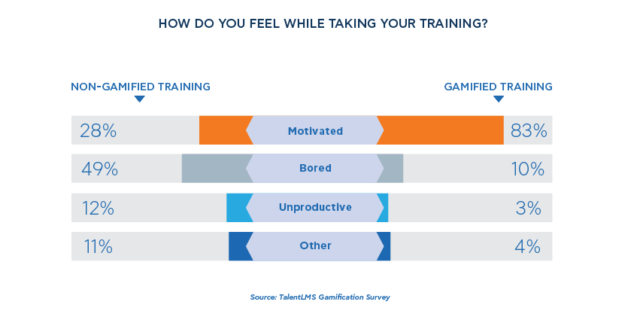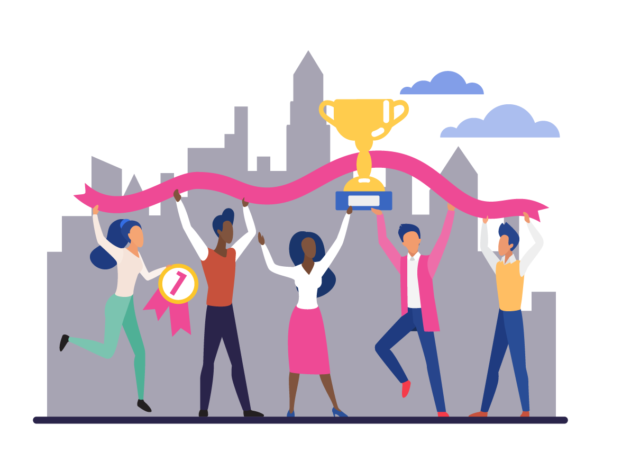How To Use Gamification at Work To Engage and Motivate Employees
How To Use Gamification at Work To Engage and Motivate Employees
The power of gamification
According to a 2019 survey by TalentLMS, gamified learning at work led to 89% of employees believing to be more productive and 88% feeling happier at work.

Gamification has the power to add productivity and motivate people. There are three very simple reasons for this. Playing:
- …makes people goal-oriented and active
- …fuels autonomy
- …is social
Let’s look at those reasons in more detail.
Playing makes people goal-oriented and active
Learning input appears to be more meaningful when actively trying to accomplish something, instead of passively taking in information. When adding some game elements to monotonous repetitive tasks, they appear more interesting. Gamified elements, such as visual progress bars make the process more rewarding. It’s easier to tackle large projects when dividing them into smaller sub-projects – for example visually with badges or levels. It also makes it easier to divide power and responsibility.
Playing games fuels autonomy
When we play, we’re in charge. We decide what we do and how. This makes us stand behind our decisions and teaches us how to take responsibility.
The feeling of autonomy greatly affects work well-being and happiness at work.
A study by Oracle in 2020 found that “Covid-19 has negatively impacted the mental health of the global workforce. […] 76% of people believe companies should be doing more to support the mental health of their workforce.” According to Oracle, a lack of company support for better well-being and happiness at work will have a great impact on employees’ productivity and loyalty towards the company.
While playing, being in charge makes us feel more powerful. When we can visually see and feel our achievements and progress, we’re more likely to believe in our own abilities. Gamification allows instant rewards, such as points, feedback, or visual proceeding, by changing levels. Feedback on completed tasks and goals gives us a sense of progression and leaves us feeling more accomplished.
The possibility to affect your choices, or to plan and schedule your work adds a feeling of autonomy – whether it’s in a gamified way or not.

Playing is social
According to a study by TalentLMS about the state of learning and development in 2022, only 32% of employees are very satisfied with corporate training. Most employees are hoping for better training at work. When looking at how training could be made more effective the study states that “People do everything better together — including learning.” Therefore, it’s not surprising that, “Almost one-third of surveyed employees say that making training more social would improve the efficacy of workplace training.” (link: Employee learning and development stats: https://www.talentlms.com/employee-learning-and-development-stats)
Playing is an interactive activity. Players are connected with each other and the game. They’re doing and experiencing something together. Therefore, they feel more related to the topic and each other. A game offers the possibility to ease discussing difficult topics or solving difficult problems.
Playing is fun. It adds effectiveness and makes boring tasks or topics more fun and engaging. Gamification helps people to grow to their full potential.
But it’s not one size fits all. Gamification methods need to be given some thought, i.e. adding too much competitiveness to the work culture in the name of gamification poses the risk of making people feel stressed and uncomfortable. Positive competitiveness however creates excitement and joy, even if we’re only competing against ourselves or trying to get better at something. The goal here is learning. Do it the right way, and you can have a team full of people who want to get better at their work and help each other grow.

Gamifying processes and trainings is easy and inexpensive
When wanting to gamify processes and trainings, one often fears that it requires a lot of money, time, and effort. On the contrary, it’s quite easy and inexpensive. Just modifying existing training materials into a more engaging form can already do wonders.
In the beginning, it’s good to sit down and think about your goals: What problem do you need to solve, and where gamification can help? A game can usually help when better commitment or engagement is wanted, but also i.e. when your company wants to better understand or put to use your personnel’s silent information and skills.
When your goals are clear, it’s time to start thinking about ways and methods to be used. A game project is like any other project. You need good planning, project management, and some methods and checkpoints to measure how your goals are met.
To measure success, personnel is usually the best resource. Collect feedback and gather inspiration. Ask the questions in the beginning. Ask for help if needed, and use the right tools, and the benefits of gamification are at your service from the get-go.
Gamifying your company’s training to engage and motivate employees is not hard. But keep in mind that planning successful game projects requires planning just like any other project.
At best, a game can bind your company’s and your personnel’s goals together, strengthen the player’s own experience of themselves as professionals, and add their self-confidence along with team spirit. If done right, gamification at work can lead to a better work atmosphere, increase the well-being of your employees and improve the cooperation of your team. Happy and motivated employees who trust in themselves and others will be more productive and bring more value to your company.
If you’re interested in learning more about gamification at work, check out our Seppo corporate training page or our Seppo solutions page